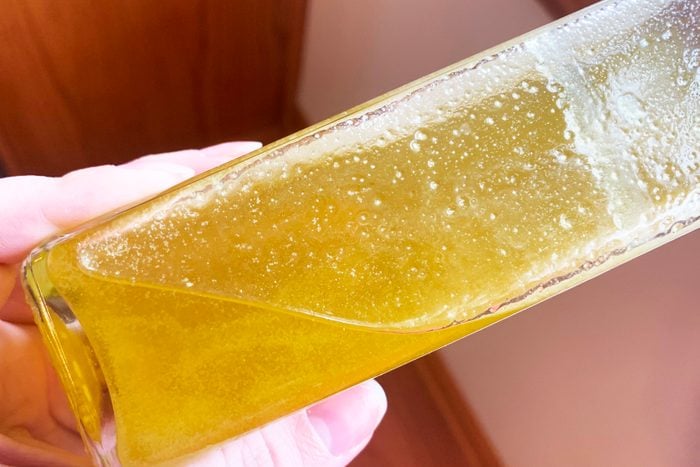If You See Floating White Stuff in Olive Oil, This Is What It Means
Updated: Jan. 04, 2024

It's not unusual to find white stuff in olive oil. It could be that the oil has gone bad—or simply mean it's cold.
Extra virgin olive oil (we are obsessed with this Graza EVOO) is a kitchen necessity, which is why it can be disheartening when a brand-new bottle looks bad. You expect each bottle to hold a clear yellow-green liquid, not see white specks floating around.
But if you come home with groceries and discover white pellets in an unopened bottle of olive oil, don’t toss it. The oil might simply be a little chilly.
Here’s how to store olive oil the right way.
What is the White Stuff in Olive Oil?
While loose fragments in your olive oil can be an indicator of the product going bad, that’s not always the case. Cold temperatures are probably the culprit behind your olive oil’s coagulation.
Like a variety of other fruits, olives have waxy, protective coatings. (Think about the shiny peel of a Honeycrisp apple.) When olive oil is placed in a cold environment, the natural waxes start to separate from the liquid, and come together in small fragments or clumps. The white stuff in olive oil might not look appetizing, but this process is natural and won’t harm the flavor.
Let’s also go over the basics of olive oil vs. extra virgin olive oil, and learn when it’s best to choose one over the other.
How to Get Rid of It
How can you tell if your oil is going bad or if it’s simply cold? If you’re on the fence about whether something is good or not, err on the side of caution. However, to know for sure, all you need to do is warm the oil up a bit.
According to Olive Oil Marketplace, quality oil that has separated due to freezing temps will return to its clear, normal consistency after it warms up. If you just got back from the store and notice the waxy white flecks floating around in your oil, let it come to room temperature. If things still look cloudy after some time, soak the bottle in a warm water bath. It should completely clarify if it’s good to use.
Don’t miss this list of surprising household uses for olive oil, like polishing shoes and cleaning stainless steel.
